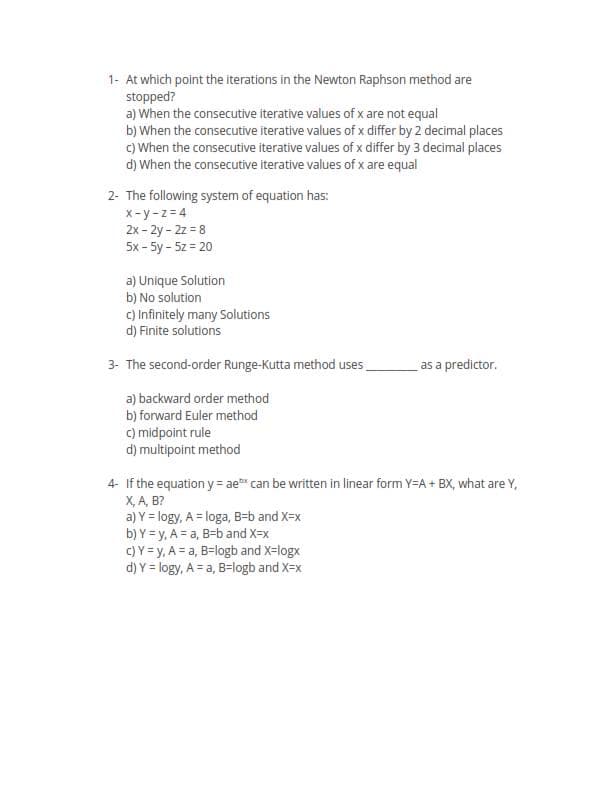4- If the equation y= ae" can be written in linear form Y=A + BX, what are Y, X, A, B? a) Y = logy, A = loga, B=b and X=x b) Y = y, A = a, B=b and X=x c) Y = y, A = a, B=logb and X-logx d) Y = logy, A = a, B=logb and X-x
4- If the equation y= ae" can be written in linear form Y=A + BX, what are Y, X, A, B? a) Y = logy, A = loga, B=b and X=x b) Y = y, A = a, B=b and X=x c) Y = y, A = a, B=logb and X-logx d) Y = logy, A = a, B=logb and X-x
Linear Algebra: A Modern Introduction
4th Edition
ISBN:9781285463247
Author:David Poole
Publisher:David Poole
Chapter2: Systems Of Linear Equations
Section2.4: Applications
Problem 17EQ
Related questions
Question
Numerical analysis

Transcribed Image Text:1- At which point the iterations in the Newton Raphson method are
stopped?
a) When the consecutive iterative values of x are not equal
b) When the consecutive iterative values of x differ by 2 decimal places
c) When the consecutive iterative values of x differ by 3 decimal places
d) When the consecutive iterative values of x are equal
2- The following system of equation has:
x-y-z= 4
2x - 2y - 2z = 8
5x - 5y - 5z = 20
a) Unique Solution
b) No solution
c) Infinitely many Solutions
d) Finite solutions
3- The second-order Runge-Kutta method uses
as a predictor.
a) backward order method
b) forward Euler method
c) midpoint rule
d) multipoint method
4- If the equation y= ae can be written in linear form Y=A + BX, what are Y,
X, A, B?
a) Y = logy, A = loga, B=b and X=x
b) Y = y, A = a, B=b and X=x
c) Y= y, A = a, B=logb and X-logx
d) Y = logy, A = a, B=logb and X-x
Expert Solution
This question has been solved!
Explore an expertly crafted, step-by-step solution for a thorough understanding of key concepts.
This is a popular solution!
Trending now
This is a popular solution!
Step by step
Solved in 2 steps with 1 images

Knowledge Booster
Learn more about
Need a deep-dive on the concept behind this application? Look no further. Learn more about this topic, algebra and related others by exploring similar questions and additional content below.Recommended textbooks for you

Linear Algebra: A Modern Introduction
Algebra
ISBN:
9781285463247
Author:
David Poole
Publisher:
Cengage Learning

Algebra & Trigonometry with Analytic Geometry
Algebra
ISBN:
9781133382119
Author:
Swokowski
Publisher:
Cengage

Linear Algebra: A Modern Introduction
Algebra
ISBN:
9781285463247
Author:
David Poole
Publisher:
Cengage Learning

Algebra & Trigonometry with Analytic Geometry
Algebra
ISBN:
9781133382119
Author:
Swokowski
Publisher:
Cengage